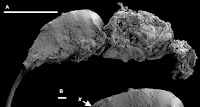The Xyelydidae are an
extinct group of Sawflies, Pamphilioidea, known from the Middle
Jurassic to Early Cretaceous of Eurasia. They are possibly ancestral
to other members of the group, though their relationships are poorly
understood, though since Sawflies are thought to be ancestral to all
other Hymanopterans (Wasps, Bees and Ants), the Xyelydidae are of
particular interest to palaeoentomologists (scientists that study
fossil Insects).
In a paper published in
the journal Alcheringa on 1 October 2015, Mei Wang of the Key Lab of
Insect Evolution & Environmental Changes at Capital NormalUniversity in Beijing, Alexandr Rasnitsyn of the PaleontologicalInstitute of the Russian Academy of Sciences and the Invertebrate Palaeontology Department at the Natural History Museum in London and
Chungkun Shih and Dong Ren, also of the Key Lab of Insect Evolution &
Environmental Changes at Capital Normal University describe a series
of fossil Xyelydid Sawflies from the late Middle Jurassic Jiulongshan
Formation of Inner Mongolia. All of the specimens are assigned to the
enigmatic genus Ferganolyda, whose morphology has proved hard
to interpret.
The first specimen
described is assigned to the species Ferganolyda scylla, which
has previously been described only from a single male specimen. The
new specimen is somewhat smaller, at 11.4 mm in length compared to 18
mm for the original, and since members of the genus Ferganolyda
are known to be sexually dimorphic, generally with larger males than
females, this specimen is considered to be female (all Hymenopterans
undergo radical metamorphosis upon reaching maturity, with a
grub-like larval stage quite unlike the adult, so all adult specimens
are known to be fully mature).
Ferganolyda scylla,
latest Middle Jurassic, Inner Mongolia, China. (A) Photo of specimen.
(B) Line drawing. Scale bars = 2 mm. N1, pronotum; psc2,
mesoprescutum; na, notaulus; scl2, mesoscutellum; v1, valvulae 1. In
all figures, cell symbols are bold and vein symbols are in regular
lettering. Wang et al. (2015).
The second specimen is
assigned to the previously described species Ferganolyda
chungkuei. The specimen is estimated to have been 21.2 mm in
length in life, though it lacks its head. It is partially covered by
a film of white carbonate material, making some features hard to
observe, though it is otherwise well preserved.
Ferganolyda
chungkuei, latest Middle Jurassic, Inner Mongolia, China.
(A) Photo of part. (B) Photo of counterpart. (C) An additional
crossvein on M+Cu of right wing of part. (D), A stub on M+Cu of left
wing of part. (E) Line drawing of counterpart. Scale bars = 2 mm in
A, B and E; 0.5 mm in C and D. PN2, mesopostnotum; cn, cenchrus;
scl3, metascutellum. Wang et al. (2015).
The third and fourth
specimens described are assigned to a new species, Ferganolyda
eucalla, meaning ‘beautiful’, a reference to the excellent
preservation of these specimens. Both specimens are thought to be
female, being 11.7 and 11.8 mm in length respectively.
Ferganolyda eucalla,
latest Middle Jurassic, Inner Mongolia, China. Photo of specimen.
Scale bar is 2 mm. Wang et al. (2015).
The final two specimens
are assigned to another new species, Ferganolyda insolita,
meaning ‘strange’, a reference to the morphology of the species.
The two specimens are considered to be a male 14.3 mm in length and a
female 16.9 mm in length. In this case the female is larger than the
male, but can be clearly identified by the presence of an ovipositor.
Ferganolyda
insolita, female specimen, latest Middle Jurassic, Inner
Mongolia, China. (A) Photo of part. (B) Photo of counterpart. (C)
Line drawing of part. (D) Line drawing of forewing of part. (E) Line
drawing of hind wing of part. Scale bars = 2 mm in A–E. pp,
propleura. Red arrows indicate a crustacean shell. Wang et
al. (2015).
All members of the genus
Ferganolyda have enlarged, broad heads. This is particularly
true of the males, which also have long and thin antennal flagella.
The purpose of these antennae is unclear, as the group has no living
representatives. Males of the living Dipteran (True Fly) family
Deuterophlebiidae have similar antennae, which they use to search for
females while patrolling over fast-moving water. However no similar
behaviour is known in any living Sawfly (or other Hymenopteran), and
the enlarged head-capsule of Ferganolyda makes it unlikely
that the males could have performed acts of sustained flight.
Ferganolyda
insolita, male specimen, latest Middle Jurassic, Inner
Mongolia, China. Wang et al. (2015).
See also…
 Two new species of Helorid Wasps from the Middle Jurasic Jiulongshan Formation of Inner Mongolia. Helorid Wasps are small, black, parasiotoid Wasps, with larvae that
develop inside the bodies of the young of Green Lacewings. The group has
a long...
Two new species of Helorid Wasps from the Middle Jurasic Jiulongshan Formation of Inner Mongolia. Helorid Wasps are small, black, parasiotoid Wasps, with larvae that
develop inside the bodies of the young of Green Lacewings. The group has
a long... A Chalcid Wasp from the Early Cretaceous of Brazil. Chalcid Wasps are among the most widespread and numerous of all Insects,
with over 22 000...
A Chalcid Wasp from the Early Cretaceous of Brazil. Chalcid Wasps are among the most widespread and numerous of all Insects,
with over 22 000... Four new species of Wasp from Cretaceous amber. Diaprioid Wasps are small parasitoids (i.e. their larvae grow inside the
bodies of other animals) that largely target Dipterans (True Flies)...
Four new species of Wasp from Cretaceous amber. Diaprioid Wasps are small parasitoids (i.e. their larvae grow inside the
bodies of other animals) that largely target Dipterans (True Flies)...
Follow Sciency Thoughts on Facebook.





